Australian water dragon
| Water dragon | |
|---|---|
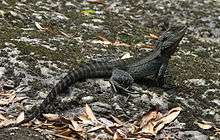 | |
| Intellagama lesueurii howittii | |
| Scientific classification | |
| Kingdom: | Animalia |
| Phylum: | Chordata |
| Subphylum: | Vertebrata |
| Class: | Reptilia |
| Order: | Squamata |
| Suborder: | Iguania |
| Family: | Agamidae |
| Subfamily: | Amphibolurinae |
| Genus: | Intellagama Wells & Wellington, 1985 |
| Species: | I. lesueurii |
| Binomial name | |
| Intellagama lesueurii (Gray, 1831) | |
| Subspecies | |
| |
| Synonyms[1][2] | |
| |
The Australian water dragon (Intellagama lesueurii, formerly Physignathus lesueurii [1]), which includes the eastern water dragon (I. l. lesueurii ) and the Gippsland water dragon (I. l. howittii ) subspecies, is an arboreal agamid species native to eastern Australia from Victoria northwards to Queensland. There may be a small introduced population on the south-east coast of South Australia.
Etymology
The specific name, lesueurii, is in honor of French naturalist Charles Alexandre Lesueur.[3]
Description
Australian water dragons have long powerful limbs and claws for climbing, a long muscular laterally-compressed tail for swimming, and prominent nuchal and vertebral crests.[4] (A nuchal crest is a central row of spikes at the base of the head. These spikes continue down the spine, getting smaller as they reach the base of the tail.)[5]
Including their tails, which comprise about two-thirds of their total length, adult females grow to about 60 cm (2 feet) long, and adult males can grow slightly longer than one metre (3 feet) and weigh about 1 kg. Males show bolder colouration and have larger heads than females.[6][7] Colour is less distinct in juveniles.[8]
Species variation
The Australian water dragon is the only species of the genus Intellagama.[1]
There are two subspecies; Intellagama lesueurii lesueurii (eastern water dragon) and I. l. howitti (Gippsland water dragon). I. l. lesueurii tends towards white, yellow and red on the throat and possesses a dark band behind its eye; I. l. howitti lacks this and instead has dark bands on either side of its throat, which is blotched with yellow, orange, or blue. Both subspecies are light greenish grey in overall colour with black bands running across their back, tail and legs. The water dragon can slowly change skin colour to aid its camouflage. The skin will shed during periods of growth.
Behaviour
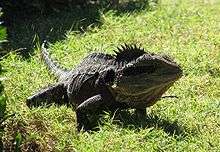
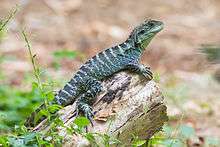
Australian water dragons are extremely shy in the wild, but readily adapt to continual human presence in suburban parks and gardens. They are fast runners and strong climbers. When faced with a potential predator, they seek cover in thick vegetation, or drop from an overhanging branch into water. They are able to swim totally submerged, and rest on the bottom of shallow creeks or lakes for up to 90 minutes,[5] to avoid detection.
Both males and females display typical agamid behaviour such as basking, arm-waving and head-bobbing. Fast arm-waving signals dominance, while slow arm-waving signals submission. Males are territorial,[4] and in areas of higher population density, males exhibit displays of aggression toward other males including posturing and chasing.
Breeding
Australian water dragons living in cooler Australian climates hibernate over winter. During spring, usually in early October, the female excavates a burrow about 10–15 cm (3.9–5.9 in) deep and lays between 6 and 18 eggs.[4] The nest is usually in sandy or soft soil, in an area open to sun. When the mother has laid the eggs, she backfills the chamber with soil and scatters loose debris over it. Australian water dragons exhibit temperature dependant sex determination; the sex of the hatchlings is determined by the temperature of the nest site.[5]
When the young are born they stay near the entrance of the burrow for some time before leaving home. When they finally leave the nest, they tend to group together away from the adult population.[6]
Habitat
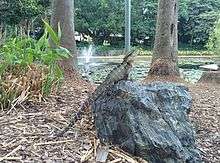
As its name suggests, the Australian water dragon is associated with water and is semi-aquatic. It can be found near creeks, rivers, lakes and other water bodies that have basking sites such as overhanging branches or rocks in open or filtered sun. The species is very common in the rainforest section of Brisbane Botanic Gardens, Mount Coot-tha in Queensland, and a monument has been built to them there.
There are anecdotal reports of a small colony living on the Sixth Creek in the Forest Range area of South Australia, which were probably introduced there during the 1980s by a local reptile enthusiast. This is many hundreds of miles outside their natural range.
Predators, threats and diet
Australian water dragons are prey to birds, snakes, cats, dogs and foxes. Nestlings and smaller juvenile water dragons are vulnerable to predation by kookaburras, currawongs, butcherbirds and other carnivorous birds.[9] They are also prone to becoming road kill due to the attraction of warm bitumen and concrete for basking.[9] The Australian water dragon's diet depends on its size. Juveniles and yearlings tend to feed on small insects such as ants, spiders, crickets, and caterpillars. When they get bigger, so does their prey. An adult diet includes small rodents such as baby mice, although insects are still the most commonly consumed.
Gallery
-

Australian water dragon, Brisbane
-

I. l. lesueurii (eastern water dragon) at Kirra, Queensland
-
Intellagama lesueurii lesueurii (eastern water dragon)
-

Swimming across river in Melbourne
-
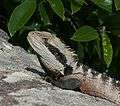
Head detail of the eastern subspecies
-
.jpg)
I. l. lesueurii (eastern water dragon) basking on a log in suburban Sydney
-

I. l. lesueurii swimming, Shoalhaven River, New South Wales
-
Australian water dragon surveying Sydney Harbour
-

Eastern water dragon at Brisbane Botanic Gardens
-

Eastern water dragon at Brisbane Botanic Gardens
-

Juvenile eastern water dragon in Roma Street Parkland, Brisbane, Queensland, Australia
-

Eastern water dragon in Brisbane Botanical Gardens
-

Head of an eastern water dragon poking out of a pond in Brisbane Botanical Gardens
-
.jpg)
Two male Australian eastern water dragons (Physignathus lesueurii ) fighting.
-

Australian eastern water dragon basking in the sun at Blue Mountains (New South Wales)
References
- 1 2 3 Amey, A.P.; Couper, P.J.; Shea, G.M. (2012). "Intellagama lesueurii (Gray, 1831), the correct binomial combination for the Australian Eastern Water Dragon (Sauria, Agamidae)" (PDF). Zootaxa. 3390: 65–67.
- ↑ "Intellagama lesueurii ". The Reptile Database. www.reptile-database.org.
- ↑ Beolens B, Watkins M, Grayson M. 2011. The Eponym Dictionary of Reptiles. Baltimore: Johns Hopkins University Press. xiii + 296 pp. ISBN 978-1-4214-0135-5. (Physignathus lesueurii, p. 156).
- 1 2 3 Maruyama, Kaori; Langkilde, Tracy, Physignathus lesueurii (PDF), James Cook University, archived from the original (PDF) on 2008-07-27, retrieved 2009-05-21
- 1 2 3 Australian National Botanic Gardens: Research into Water Dragons Archived June 30, 2007, at the Wayback Machine.
- 1 2 "Critters of Calamvale Creek: Eastern Water Dragon". Calamvalecreek.awardspace.com. Retrieved 2013-07-09.
- ↑ Australian Museum Online: Wildlife of Sydney
- ↑ "Critters of Calamvale Creek: baby Eastern Water Dragon". Calamvalecreek.awardspace.com. Retrieved 2013-07-09.
- 1 2 Australian National Botanic Gardens: Predators of Water Dragons Archived November 21, 2008, at the Wayback Machine.
Further reading
- Boulenger GA. 1885. Catalogue of the Lizards in the British Museum (Natural History). Second Edition. Volume I. ... Agamidæ ... London: Trustees of the British Museum (Natural History). (Taylor and Francis, printers). xii + 436 pp. + Plates I-XXXII. (Physignathus lesueurii, pp. 398–399).
External links
| Wikimedia Commons has media related to Physignathus lesueurii. |
| Wikispecies has information related to: Physignathus lesueurii |
- Australian water dragon at the Encyclopedia of Life

- Australian National Botanic Gardens Research
- Maruyama, K.; Langkilde, T. (1999). "Physignathus lesueurii " (PDF). Archived from the original (PDF) on 2008-07-27.
- "Physignathus lesueurii ". James Cook University - Discover Nature.
- Reptiles of Lamington National Park. "Physignathus lesueurii ".
- "Physignathus lesueurii howittii ". ozanimals.com.
- Physignathus lesueurii at the Reptarium.cz Reptile Database